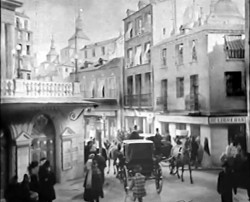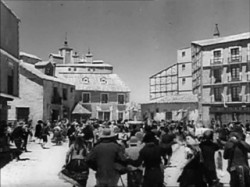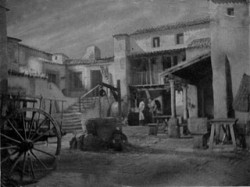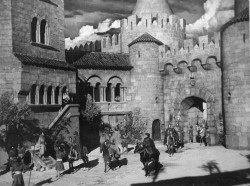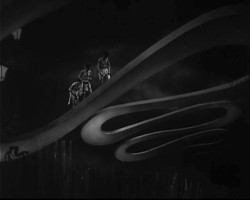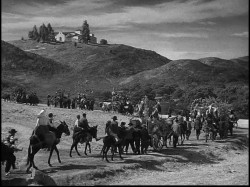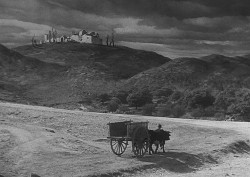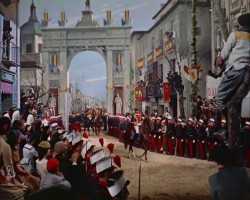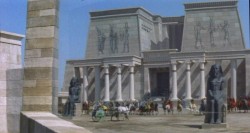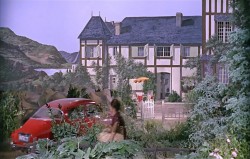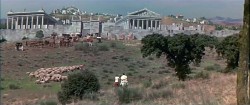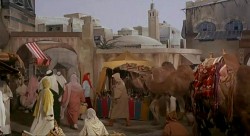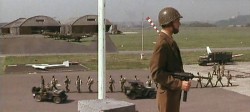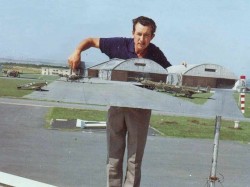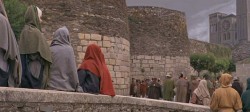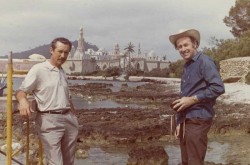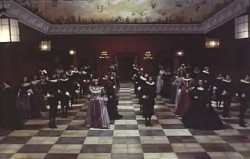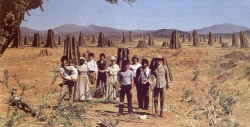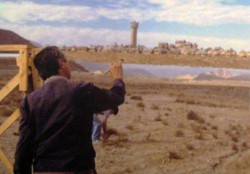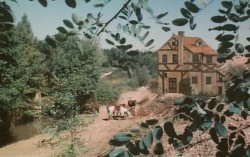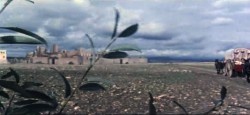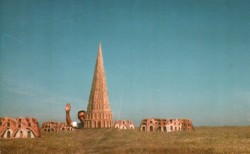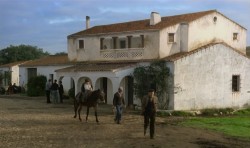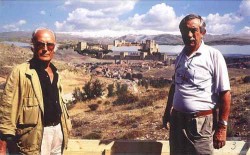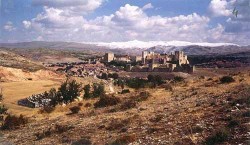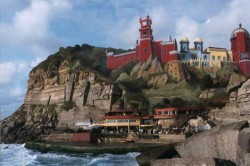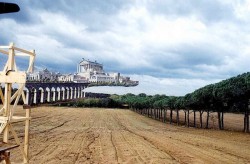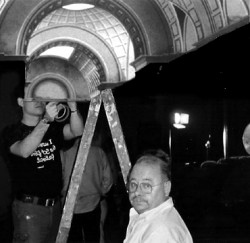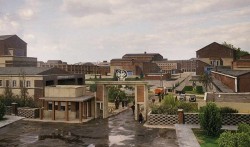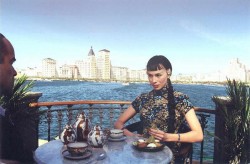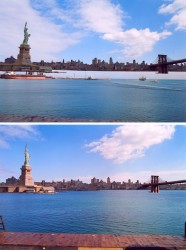1940. Pierre Schildneck Russian designer, who moved to France and then to Spain, painted glass shots for “La florista de la Reina” (1940) and “Pepe Conde (1941) with Enrique Alarcon as an assistant.Schildneck used the technique of matte painting he learned with Percy Day in France. He filmed the shot masking the areas which he will paint over, and then paint the glass in his studio filming again the glass on the original negative.
1942. Enrique Salva and a young Emilio Ruiz as an assistant, begun to paint in camera glass shots for art director Sigfredo Burman in “El abanderado” They use the technique of ” glass shots” placing the glass in front of the camera, and painting the miniature with direct reference of the real stage, filming the painting with the actors at once.
1944. Pierre Schildneck as chief designer for the film “La torre de los siete jorobados” uses miniature models and matte paintings to recreate the underground city under Madrid.
1946. For “Dulcinea” Enrique Salva and Emilio Ruiz paint a glass shot for the upper part of sets and sky into the studio.
1948. Enrique Salva y Emilio Ruiz made several glass paintings for Sigfredo Burman in “Locura de amor”
1948 For the Portuguese-Spanish coproduction Ines de Castro” Pierre Schild painted several mattes to complete medieval sets.
1948. Art director Alfonso de Lucas executed some glass shots for the film, “Don Juan de Serrallonga”. painting the second floor of the house and the sky.
1950. Pierre Schildneck paints on glass the Gran Via street in Madrid for “El ultimo caballo”.
1951. Enrique Salvá and Emilio Ruiz painted several glass shots for Sigfredo Burman in “Alba de America”. ( At left is E.Salvá, at right E. Ruiz).
1952 Alfonso de Lucas used a glass shot trick for the film “los ases buscan la paz” He pasted a photo of Budapest and added some painted houses to match the foreground set.
1954. Art director Juan Alberto Soler after working with Pierre Schild , painted some glass shot for his films, like “El duende de Jerez”
1955. For the film “Marcelino pan y vino”, Pierre Schildneck uses the technique of matte painting to create the abbey on the hill.
1955. Emilio Ruiz paints a cityscape in a glass sheet for “Cruz de Mayo” The glass breaks and he repeats the paint on a sheet of a wood silhouette. This method he perfected over the years, painting on cut out aluminum sheet.
1957. Enrique Salvá travels to Mexico and paints mattes for “Cabo de Hornos” When back to Spain he died in a traffic accident.
1958 . Antonio De Miguel, scenic painter, and assistant of art director Enrique Alarcon executed several glass paintings for “Donde vas Alfonso XII?”
1959. Emilio Ruiz paints glass shots for “The legions of Cleopatra” and “The last days Pompeii ” beginning a long term collaboration on Hispano-Italian co-productions, mostly peplums, Spaghetti westerns, and war films.
1960 – Pierre Schild retired from movies. After Enrique Salvá death a few years earlier, Emilio Ruiz remains the only artist specialized in this technique. Although some other scenic artists and art directors continue to paint on glass occasionally.
1960 Juan Alberto Soler painted some glass shots for “Gaudi” to recreate the construction of some monuments and buildings designed for Architect Antonio Gaudi.
1961. Antonio de Miguel painted a glass shot of old Peruvian City of Lima, for the film “Fray Escoba”.
1963. Antonio De Miguel painted glass shots for art director Enrique Alarcon for many films like “Rocío de la Mancha”
Perseo l’invincibile (1963) Emilio Ruiz painted glasses foe many Sword and Sandal movies, most of them filmed in Spain and Italy.
1965. Juan Alberto as art director of Itali-Spanish film “Toto de Arabia” painted a glass shot to complete the upper part of an Arabian style set.
1967. For the war film Dirty Heroes (1967) “Dalle Ardenne all’inferno” Emilio Ruiz makes several glass shots using his cut out aluminum technique.
1967. in addition to his tasks as an assistant art director, Antonio de Miguel paints a glass shot for “Cotolay”
1973 . Emilio Ruiz painted miniatures on cut out aluminum for Ray Harryhausen´s “The 7th Voyage of Sinbad”.
1977. Emilio Ruiz began a fruitful collaboration with Juan Piquer Simon at “Journey to the Center of the Earth.”
1980. scenic artist Julian Martin Benito, paint his first glass shot for the film “Jalea real” beginning a career as a glass painter for over twenty years.
1981. Emilio Ruiz make model miniatures and glass shots for “The Sea Devils” by Juan Piquer
1981. Emilio Ruiz supervised foreground miniatures and glass shots for “Conan the barbarian” He begins a long term collaboration with Dino de Laurentiis.
1982. Julian Martin oversees the miniatures and glass shots for TV series “Teresa de Jesus”
1983. Art director Julio Esteban painted on a masonite cut out for the film “La loca historia de los tres mosqueteros” to recreate a typical French inn for XVII century.
1984. Art director Julio Esteban painted an Islamic city on a masonite cut out for the comedy “Cuando Almanzor perdió el Tambor”
1984. Francisco Prosper set designer and model maker, painted a few glass shoots for the film “La Biblia en pasta “
1984. Julian Martin painted on glass the top of the mansion for “Los santos inocentes” by Mario Camus.
1986. Emilio Ruiz oversees the miniatures and glass shots for Dino de Laurentii´s “Taipan”
1987. Francisco prosper executes several glass paintings for Italian-Spanis coproduction “Los alegres picaros” He erase modern buildings, street lights and Tv antennas painting in glass period buildings, trees walls, etc.
1989. For the TV series “la forja de un rebelde” Julian Martin was responsible for miniatures and cut out paintings to recreate the city of Madrid at the early 20th century.
1991. For the film “Christopher Columbus, the discovery” Emilio Ruiz painted on glass the medieval city of Granada and surrounded mountains.
1991- For TV series “Historias del otro lado” Julian martin executed several in-camera cut out foreground paintings.
1992. The art director Gonzalo Gonzalo executed two glass shots for the film “La vida lactea”.
1994. Emilio Ruiz paints Rome on glass for the Italian comedy “S.P.Q.R. 2,000 and a half years ago”
1998. Julian Martin among other miniatures, painted a cut out masonite for the ceiling of the Prado Museum for “La hora de los valientes”.
1998. For “La niña de tus ojos” by Fernando Trueba, Emilio Ruiz painted on glass the German UFA studios in the late 30s.
1999. To recreate the city of Barcelona at early years of 20th century Julian Martin painted several glass shots for “La ciudad de los prodigios”
2001. Again for Fernando Trueba, Emilio Ruiz paints the Shanghai of the 40s, on a masonite cut out placed behind the actors for “El embrujo de Shanghai”
2007. Emilio Ruiz dies shortly after completing a New York painting for “Luz de domingo”
